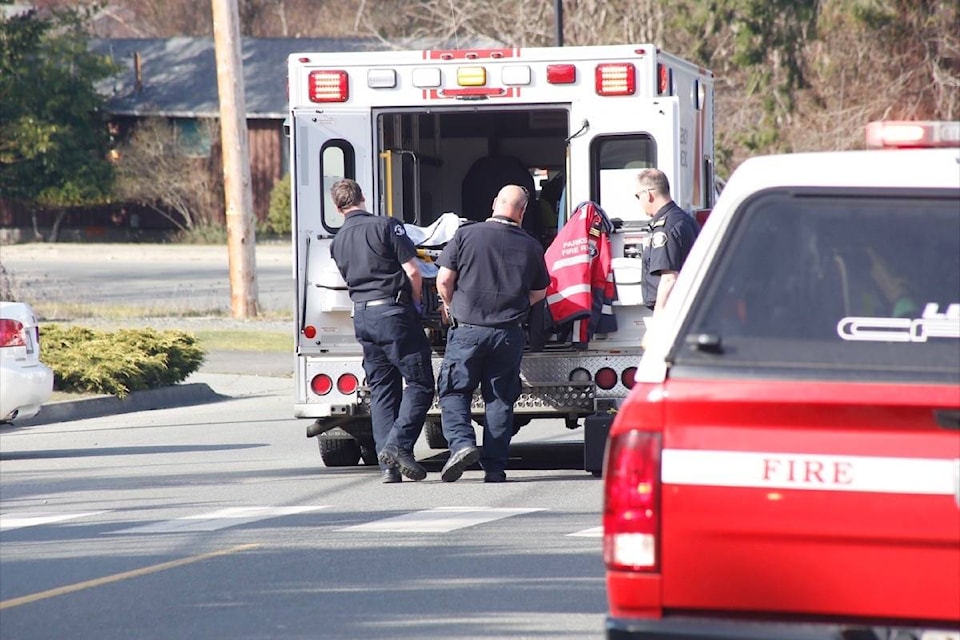This part two of a two-part series examining drug use on the West Shore. Find the first installment online here.
Overdose deaths are not just a downtown problem and local first responders want to dispel the stigma that may be preventing some people from getting help.
“We’re seeing everything from the young kids to the 80-year-old grandmas,” said Brad Cameron, B.C. Emergency Health Services superintendent of patient care delivery for Greater Victoria. “This is the new norm … Fentanyl is still the drug, nothing has replaced it yet.”
Contrary to popular belief, Cameron said first responders are not just seeing deaths in the downtown core.
“All the deaths are in the bedroom communities and in our neck of the woods [on the West Shore],” Cameron explained, adding people aren’t dying at supervised consumption or overdose prevention sites because staff and bystanders are hyper vigilant.
Despite its potentially deadly side effects fentanyl and carfentanyl give users a gripping high. And while it’s hard for some to understand why anyone would take it, Cameron tried to explain the rationale behind it. “A fellow said to me: ‘picture yourself in a bitter winter’s day and it’s like being immediately immersed in a warm bath’ … It’s a powerful reason to take it.” But while some are taking it on purpose, others are unaware they are about to ingest the deadly drug as Cameron said they are finding it in everything except marijuana and alcohol.
READ MORE: Grade 10 Belmont student dies from suspected overdose
With the recent deaths of two high school students, and June being a notorious party month for teens, Cameron said they’re gearing up for a busy summer and are already on high alert. “We haven’t seen a huge increase in the younger kids but who knows … maybe the kids don’t know they’re taking it.”
In response to the ongoing opioid crisis, an additional ambulance was added last year to the region’s rotation, specifically to handle the increase in overdose calls.
“That car is still working 12 hours a day … and it’s as busy as any other ambulance out there,” Cameron said. “It’s still a huge problem.”
Along with other initiatives, such as a bike squad that was rolled out even earlier this year, BCEHS also started a trial six months ago in Greater Victoria that has ambulances stocked with naloxone kits. When crews respond to an overdose call in an outlying area they either replace a naloxone kit that was used or provide one to a responsible person involved with the call.
Each kit comes with an instruction sheet, with more information available online, so crews don’t need to spend time teaching people how to administer naloxone, which can temporarily block the effects of opioids.
Cameron noted the program has been quite successful and is now being used Island-wide with the intention of taking it provincewide.
READ MORE: Recreational drug users hit hardest
Across the country the opioid overdose epidemic claimed nearly 4,000 lives last year, according to new figures released this week by Health Canada. That’s a 34 per cent increase or approximately 1,000 more deaths than 2016. Deaths involving fentanyl or fentanyl analogues increased to 72 per cent, up from 55 per cent in 2016, and 92 per cent of opioid-related deaths were accidental or unintentional.
But in B.C. fentanyl was detected in approximately 84 per cent of deaths in 2017 and 83 per cent so far in 2018, according to the B.C. Coroners Service. In April, the most recent figures available, there was an average of four deaths per day, bringing the total for the year to 511. Vancouver, Surrey and Greater Victoria continue to see the highest numbers.
While overdose calls to View Royal Fire Rescue are down slightly this year, Chief Paul Hurst said it’s not because the problem is going away.
“I think it’s simply becoming more hidden and being dangerously self-managed … My sense is, with the influx of naloxone into the public stream and more people having access to it, they are perhaps self-managing overdoses and not calling 911. The obvious danger in this is that the naloxone is temporary and we have seen cases where a patient who has been administered naloxone recovers from the unconscious state, only to go unconscious again after a period of time.”
Hurst added overdose patients that aren’t taken to the hospital for assessment and treatment run the risk of dying if they are left alone after being given naloxone.
“I still feel there is considerable stigma attached to the drug use issue and people are still reluctant to call for help. Paramedics and fire first responders are not here to judge, we’re here to help,” Hurst said. “Not calling, and self-diagnosing and administering naloxone without additional pre-hospital care, puts people at tremendous risk.”
READ MORE: More than just users affected
It’s a sentiment echoed by Cameron and Langford Fire Chief Chris Aubrey.
Aubrey noted overdose calls are also down slightly in Langford, probably because naloxone kits are now widely available. But he added, “I believe the solution to this is complex and multi-faceted and will require many strategies and groups – addictions counselling, emergency services, harm reduction, government, medical – to come together and find ways to reduce overdoses in our communities. Until that time, the fire service and BCEHS will continue to respond and help those in need when called upon.”
And having someone who is sober there to administer naloxone and call emergency medical help when needed is key said Cameron. “If you’re going to use, do not use alone … That’s when people die.”
